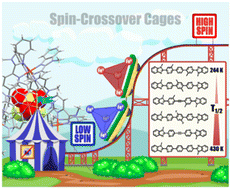Tuning the spin-crossover properties of Fe II4L6 cages via the interplay of coordination motif and linker modifications†
Abstract
Despite the increasing number of spin-crossover FeII-based cages, the interplay between ligand modifications (e.g. coordination motif substituents and linker) is not well-understood in these multinuclear systems, limiting rational design. Here, we report a family of FeII4L6 spin-crossover cages based on 2,2′-pyridylbenzimidazoles where subtle ligand modifications lowered the spin crossover temperature in CD3CN by up to 186 K. Comparing pairs of cages, CH3 substituents on either the coordination motif or phenylene linker lowered the spin-crossover temperature by 48 K, 91 K or 186 K, attributed to electronic effects, steric effects and a combination of both, respectively. The understanding of the interplay between ligand modifications gained from this study could be harnessed on the path towards the improved rational design of spin-crossover cages.



 Please wait while we load your content...
Please wait while we load your content...